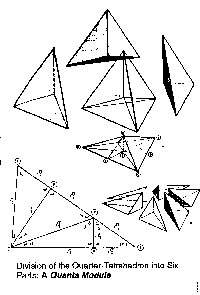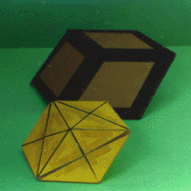Playing With BlocksChildren raised with the stereotypical rectangular blocks (with a few right triangles and pillars mixed in) can stack them compressionally against the downward pull of gravity, thereby recapitulating the story of civilization. But crystallographers, weaned away from strict Cartesian rectilinearity by nature's iso- and icomatrix structures, are less bound by architectural convention. They have their so-called fat and thin rhombohedra to play with. Given a set of such nonrectilinear blocks, a much larger variety of polyhedra may be assembled. Synergetics continues the venerable tradition of seeking to relate the polyhedra to a minimum inventory of modules. Fuller's A and B mods, for example, are irregular tetrahedra that combine to form those members of the volumetric hierarchy aligning with the isomatrix: the tetrahedron, cube, octahedron, rhombic dodecahedron and vector equilibrium. These are also the polyhedra that are found in spherical outline within the 25 great circle grid. Members of the fivefold family such as the rhombic triacontahedron, which are chordally outlined by the framework of 31 great circles, are out of range of the A and B modules. Additions to our minimum inventory are necessary. |

|
| In his Hierarchy of an Icosahedron, a well-crafted HyperCard stack featuring animated computer graphics, Yasushi Kajikawa resolves the five-fold family of polyhedra into ten basic irregular tetrahedral and octahedral modules, which he envisions in the context of a nonperiodic, quasi-crystalline "icomatrix," named in contradistinction to Fuller's isomatrix, home to the less disquieting, traditional crystal lattices. Kajikawa's blocks, which he names "synergetics modules," build outwardly, starting from an icosahedron, to form the pentagonal dodecahedron and rhombic triacontahedron on the way to forming an icosahedron of the next higher frequency, and so on ad infinitum, to fill space. In a plane, Kajikawa uses his modules to duplicate the patterns formed by Penrose tiles. | Planar Tessallations |
|
David Koski, another synergetics pioneer, has developed
a set of equivolumed irregular tetrahedral modules from the dimensions
of a rectangular prism having edge ratios of 1.618 to 0.618 to
1, the so-called golden cuboid. The golden cuboid's edges, face
and body diagonals provide an inventory of seven distinct segments
which, taken six at a time, define the seven Koski modules, one
of which is angularly identical to Fuller's T-module, 1/120th
of a rhombic triacontahedron. Koski's method for assembling the
fivefold family is to choose a "zero level" relative
to which his modules are able to grow and shrink to higher and
lower levels by steps calibrated by positive and negative powers
of the golden proportion (1.618). In other words, a "level
one" module would have all its edges stretched by 1.618,
while the next level higher would have its edges multiplied by
this constant yet again.
Koski discovered that the T-mod self-assembles recursively from an infinite series of phi-stepped T-mods. The icosahedron assembles finitely using three alternate (non-T) Koski modules spanning four levels. The cube is likewise a finite level-spanning assembly. Both Koski and Kajikawa are able to use their modules to assemble the truncated icosahedron, the chordal network corresponding to buckminsterfullerene. |

|
|
| |